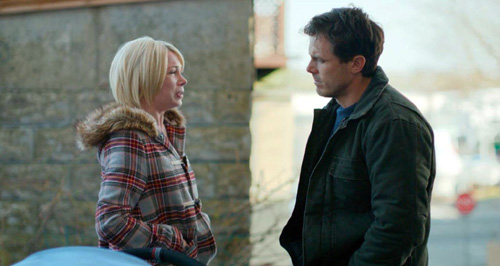|
Hold fast to dreams
For if dreams die
Life is a broken-winged bird
That cannot fly.
—Langston Hughes
Three extraordinary new films offer variations on the effect of dreams on the human psyche—what happens when they die or turn sour, and
how even when fulfilled they aren’t always everything you want.
Damien Chazelle’s La La Land exemplifies that last principle. From its glorious opening number—“Another Day of
Sun,” set in an endless Los Angeles traffic jam—to its bittersweet end, La La Land is a meditation on both the fragility and necessity of dreams. It
reaffirms, and in a way transcends, the movie musical as a vector for deep emotion; it also is a poignant acknowledgment that most of the kids who move to L.A. will never achieve
their ambitions.
La La Land is the story of Mia (Emma Stone), an aspiring actress, and Sebastian (Ryan Gosling), a jazz pianist. They first cross
paths during a road rage incident in the opening traffic jam, and they continue to cross paths over many months before they even learn to like each other. (Two numbers in
particular—“A Lovely Night” and “City of Stars”—trace their path from mutual disenchantment to ardent love.) Both live in a bubble of
constant professional frustration, which adds to the initial friction between them. Mia endures the usual round of unsuccessful auditions, mostly for parts beneath her
talent; Sebastian, having been cheated by a business partner, has to take any gig he can get just to pay his debts. (Many of the scenes of professional humiliation are taken
directly from the actual experiences of Stone, Gosling, and Chazelle; Chazelle had to wait six years to make La La Land, and only the success of Whiplash finally attracted investors.)
 |
La La Land presents the arc of Mia and Sebastian’s relationship simultaneously with the slow, unsteady but upward trajectory of
their careers. Even as their lives improve, Chazelle reminds us that things change, and not always for the better. Early in the
movie, Mia passes the movie theater where she and Sebastian will finally fall in love; later, she passes the same theater, and it
is closed. (The same theater will be the scene of an event that changes Mia’s life forever.)
La La Land swirls with color, light, and energy, thanks not only to Chazelle but to his collaborators: photographer Linus
Sandgren, film editor Tom Cross, production designer David Wasco and especially composer Justin Hurwitz, who also composed the music for Whiplash. Stone and Gosling are
superb, and although they are not great singers or dancers, they put Hurwitz’s songs across in fine style. (One of Stone’s best
scenes is her singing of “The Fools Who Dream,” a song about her aunt who moved to Paris.) Other notable, if brief,
performances include those of J.K. Simmons as a sour-tempered club owner, Rosemarie DeWitt as Sebastian’s disapproving sister
, and John Legend as a bandleader who hires Sebastian.
La La Land isn’t perfect; the story drags in the middle section, and the final conflict between Mia and Sebastian seems just a
little contrived. Nevertheless, the film at its best has a robust yet poignant charm that few films offer today. For me, it isn’t
reminiscent so much of Hollywood musicals as of Jacques Demy’s The Umbrellas of Cherbourg, another delicate,
dazzlingly beautiful musical about destiny and youthful dreams. Even more, La La Land can be taken as a tribute to those
hundreds of youthful actors, singers and dancers on screen, most of whom will never achieve stardom but can at least say they were in La La Land.
In contrast, Denzel Washington’s Fences and Kenneth Lonergan’s Manchester by the Sea come from places where
dreams die, and die absolutely. The main difference in the focus of the two movies can be delineated by the main characters: Troy Maxson of Fences can fairly be described as Shakespearian,
whereas Lee Chandler of Manchester by the Sea seems like a collaboration between Eugene O’Neill and Samuel Beckett.
Fences, of course, is a cornerstone of one of the most monumental achievements of the American theater—the
Pittsburgh Cycle, August Wilson’s 10 plays about the African-American experience, each set in Wilson’s native Pittsburgh in a
different decade of the 20th century. Fences,set in the 1950s, may be the best of the lot, and it has been acknowledged as a
masterpiece since its premiere in 1987. Washington’s Fences is the film version of the 2010 Broadway revival of the play, for
which he and co-star Viola Davis won Tonys.
In Troy Maxson, Washington has given himself one of the greatest roles in the contemporary theater, and he knows exactly
what to do with it. Troy is a 53-year-old sanitation worker who, as the play opens, is fighting the Pittsburgh Department of
Sanitation for the right to drive a garbage truck, which is a step up from handling garbage cans. “Fight” is probably the defining
word of Troy’s existence. Just about everything he has, he had to fight to get, and what he wanted most eluded him. A former
baseball player in the Negro Leagues, he is permanently embittered that he was deemed too old when the Major Leagues
were finally integrated. He keeps a bat and a baseball dangling from a string in his backyard; this becomes a crucial plot point.
Troy insists on ruling his little backyard in his crumbling Pittsburgh neighborhood, and it is his incessant demands that
cause most of the conflict in Fences. His wife Rose (Davis) bears up as best she can, but their son Cory (Jovan Adepo) rebels.
Cory, a high-school football player, is being courted by college recruiters, but the proudly illiterate Troy sees this as a scam.
Far better, he lectures Cory again and again, to learn a trade and get a job.
Troy is just as scornful toward Lyons (Russell Hornsby), his son from an earlier marriage and an aspiring jazz musician. Troy
mocks Lyons for borrowing money, spurns his effort to pay the money back, and resolutely refuses to go hear Lyons play.
Rounding out Troy’s little kingdom are Bono (Stephen McKinley Henderson), his easygoing but astute best friend, and Gabe
(Mykelti Williamson), his brain-damaged younger brother.
Troy is a great self-mythologizer, and he speaks in monologues that consist mostly of tall tales larded with baseball terminology.
These are some of the most amazing monologues in the modern theater, and Washington mesmerizes the audience with them.
So the audience is just as horrified as Rose when Troy, still sputtering baseball slang, makes a fateful admission. Rose, after
having stood by Troy for many years, finally expresses her rage and sorrow in a monologue of her own. It is magnificent, and so is Davis in performing it.
Washington does his best to open up Fences for the screen, but it remains a filmed play, and appropriately so. That tiny
backyard, where Troy and Cory labor incessantly at building a fence (fences, Rose notes at one point, keep people both out and
in), is the perfect backdrop for these shattered people and their dimming but persistent hopes. Endemic racism, the highest
fence of all, is never discussed openly but is omnipresent, warping the lives and expectations of all the characters. A gate is
just starting to open in that fence; to Cory, it looks bigger than it actually is, whereas Troy can’t see it at all.
The entire cast of Fences is brilliant; among the supporting players, I was especially moved by Williamson, who is fiercely
poignant as the mentally disabled Gabe. Fences should, and probably will, bring Viola Davis the Oscar she has long deserved. If Denzel Washington doesn’t win an Oscar, it will only be
because of Casey Affleck, who beat Washington for the Golden Globe. Affleck vs. Washington is a textbook case of apples vs.
oranges; Affleck’s performance as Lee Chandler in Manchester by the Sea is far quieter and more laconic than Washington’s in Fences,but in its own way just as extraordinary.
Manchester by the Sea opens with Lee living a solitary life as the superintendent of an apartment building in Quincy, Mass. The
tenants don’t like him, he doesn’t like them, and the landlord is constantly getting complaints about him. At night he goes alone
to bars, guzzling beer till closing time. He picks fights with the men, and can’t say two words to the women.
On an appropriately wintry day, Lee receives a call: his older brother Joe (Kyle Chandler), who has suffered for years from
congestive heart failure, has died. He must go back to his eponymous home town to help arrange the funeral and look after his teenage nephew Patrick (Lucas Hedges).
Two things are obvious at this point. First, Lee carries with him an enormous load of inner pain and sorrow; second, his
reputation among the people of Manchester is not good. Kenneth Lonergan tells the story in flashbacks, showing us that
Lee was once close to his family, and that an unspeakable tragedy (which I will not disclose here) essentially shut down
his life.
Manchester by the Sea is a marvel, playing out like a fine novel yet remaining intensely cinematic. One of the hallmarks of
Lonergan’s screenplay is its total rejection of melodrama. There are no sudden epiphanies, and all the biggest dramatic scenes
are masterfully underplayed. This is especially true of the scene toward the end when Lee and his ex-wife Randi (Michelle
Williams) meet each other by chance on the street, after years of not speaking. This scene deserves to be shown forever in acting classes around the world.
 |
Lonergan is especially sensitive to the development of his characters. They may not do the things we want them to, or
come to their senses as quickly as we hope, but they remain absolutely consistent, always and only doing what we could
rightly expect them to. Lee has lived for years in a cocoon of grief and guilt, his apartment as close to a prison cell as he can
possibly make it. All his dreams have become nightmares; we see one of them toward the end of the film, so quiet that it takes
several seconds for its full horror to sink in. Patrick is dealing with grief for the first time in his life; one of the most moving
scenes in the film is when he simply stares at a package of frozen chicken (you will need to see the film to understand the
context). In between there are equally powerful moments with supporting characters, such as Patrick’s mother Elise (Gretchen
Mol), an unstable alcoholic who ends up trading one addiction for another.
Manchester by the Sea is blessedly laced with flashes of humor, most of them dealing with Patrick and his entanglements with
various girls. The film ends with a delicate scene of hope, the perfect end to a very nearly perfect film. I was fortunate enough
to see three authentic cinematic masterpieces this year: Atom Egoyan’s Remember, David Mackenzie’s Hell or High Water, and Barry Jenkins’ Moonlight. Manchester by the Sea is the
fourth, and it may be the best of the four. Certainly it shows us that it is possible, after a life of nightmares, to once again consider a return to happy dreams.
|